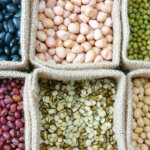Fabulous Fibre

We know that fibre should be an integral part of our diet. It has a multitude of health benefits which include lowering cholesterol, stabilising blood sugar levels, feeding gut bacteria, eliminating toxins and even preventing obesity.
But in our fast paced society, it’s not always easy to meet the recommended requirements. On the contrary, too much fibre can make you feel uncomfortable, particularly if the intake is suddenly increased. So how do we make sure we’re getting it right?
I’ve just returned from a wonderfully relaxing holiday in Turkey, feeling refreshed and ready for autumn. With the change of season, and the unwelcome bugs and viruses that come with it, now is a particularly important time to take care.
How much fibre do we need?
The recommended daily fibre intake is 25-30 grams for women and 38 grams for men. To put this into perspective, a 40g serving of porridge oats contains 3.6g of fibre, a handful of nuts has around 3g and an apple will give you 4.4g. If you think you need to increase your fibre intake, it should be done gradually otherwise you might experience bloating or gas.
Could your fibre levels be too low?
Digestive health affects our overall wellbeing, but it’s not always easy to tell if something is wrong. Our bowel movements give a clear indication, and this is often a starting place with my clients. What is perceived as normal can vary from one person to another. Here are the main symptoms to look for:
- Constipation
- Sluggish bowels
- Small stools
- High cholesterol
- Blood sugar problems
High fibre foods
There are seven types of fibre: bran, cellulose, gum, hemicellulose, lignin, mucilage and pectin. Each has its own function and can be found in varying quantities in these foods below. Make sure you’re getting enough by rotating your diet:
- Beans and lentils – These have the highest fibre content. Add to stews, curries and salads.
- Vegetables– Low in calories and high in antioxidants, what’s not to love! They are so important for children too.
- Fresh fruit and dried prunes/dates – Add to your breakfast or choose as a snack.
- Nuts – Try a handful a day.
- Seeds – Flaxseeds are particularly fibre-rich. I soak oats overnight in water or milk/almond milk with flax seeds, chia seeds and desiccated coconut. I then add frozen berries and a banana the next morning to make a delicious breakfast.
- Brown rice and whole grains – Quinoa is a great source.
Additionally, fibre comes in two forms: soluble and insoluble. The difference is in how they are digested.
Soluble fibre
Soluble fibre attracts water and helps slow down the digestive process to make you feel fuller for longer. It turns into a gel-like substance during digestion, in the same way porridge oats turn gooey when you cook them with water. You’ll find soluble fibre in fresh fruit, oats, vegetables, beans, nuts and seeds.
Soluble fibre prevents some of the dietary cholesterol from being broken down and digested, and over time, a high fibre diet can lower cholesterol levels in the blood. It also slows down the absorption of sugar and carbohydrates, so your blood sugar levels are less likely to spike after a meal. It is excellent for weight management, as the thick, gel-like substance blocks fats that would otherwise be digested and absorbed. Apple pectin, a soluble fibre naturally present in apples, is very effective at removing toxins and also helps to lower cholesterol. Enjoy two apples a day (skin on); start with one if you don’t usually eat them.
Resistance starch is a fermentable form of soluble fibre. Starch molecules resist digestion in the small intestine and ferment in the large intestine, acting as a prebiotic (food for the good bacteria). You’ll find this in green bananas, white beans, lentils, and cooked and cooled potatoes and rice. Cook extra potatoes (skin on) or rice, and eat cold (do not reheat) the next day, or make a potato or rice salad.
Insoluble fibre
Insoluble fibre is the indigestible part found in the outer layer of vegetables and fruit. It moves through the digestive system adding bulk to your stools, whilst speeding up the movement and processing of waste. It helps with haemorrhoids, varicose veins and constipation. You’ll find insoluble fibre in celery, cucumbers, courgettes, root vegetables, fruit with edible seeds, brown rice, pulses, nuts and seeds.
If you find it difficult to increase your fibre intake, supplements could be used short term, but I would always recommend looking at your diet first.
